Road signs, or traffic signs, guide drivers and other road users. Not only do they regulate the traffic flow, but they also warn about road hazards and obstacles that may not be obvious.
Some traffic signs, like “STOP,” “YIELD,” or “WRONG WAY,” are the same all over the world. Others, however, vary between countries or states. Here’s what you should know about California road signs.
Types of California Road Signs and Their Meanings
California has approximately 500,000 road signs, including 20,000 overhead guide signs. These fall into several categories and come in different shapes and colors.
Each sign conveys a distinct message – usually through images. Let’s take a look at the main categories of traffic signs in California.
Traffic school can help you keep a clean driving record, prevent insurance increases, and more!
Regulatory Signs in California
The regulatory driving signs in California tell road users what they can and cannot do. Their role is to ensure compliance with traffic laws and regulations.
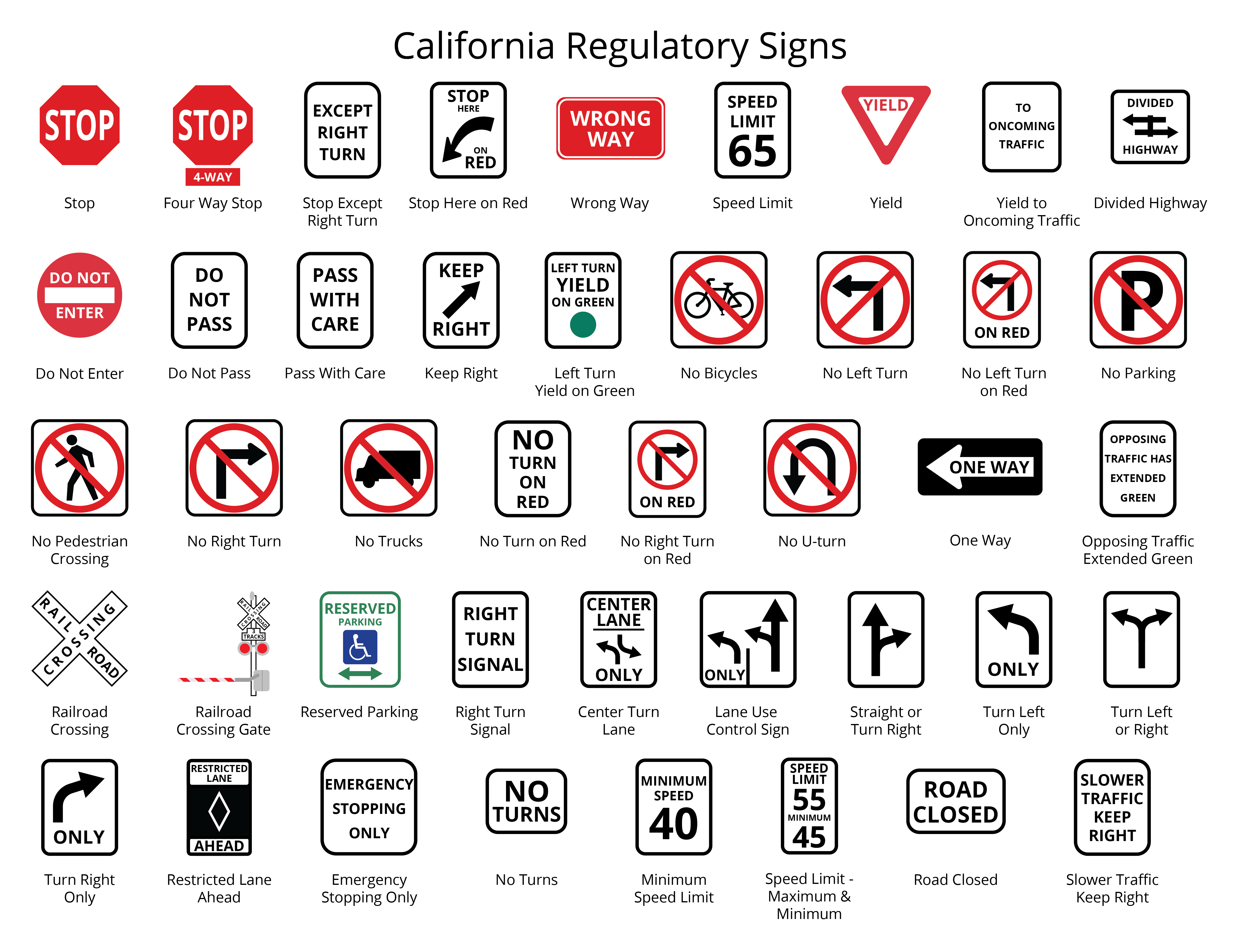
Many of these signs are pretty easy to understand. Here’s an overview of the ones you might be confused about.
- Yield to Oncoming Traffic: Give priority to any cars, bicycles, or pedestrians crossing the street in front of you.
- Pass with Care: This sign marks the end of a no-passing zone. When you see it, you may pass, but only when it’s safe to do so.
- Keep Right: You may pass, but you must drive to the right of the obstacle where the sign is posted.
- Left Turn Yield on Green: You can turn left on a green light but must yield the right-of-way to oncoming traffic.
- Opposing Traffic Has Extended Green: Vehicles coming from the opposite direction may continue to move when your light turns red.
- Right Turn Signal: This road sign marks a dedicated signal for vehicles turning right.
- Center Turn Lane: Drivers can use the center lane to turn left in either direction of travel.
- Lane Use Control Sign: This traffic sign tells you which lanes of a street or highway are open and which ones are closed. This can change depending on the flow of traffic.
Warning Signs in California
Warning traffic signs warn drivers of closed roads and other obstacles or potential hazards. They’re often placed close to bicycle crossings, roundabouts, or railroads.
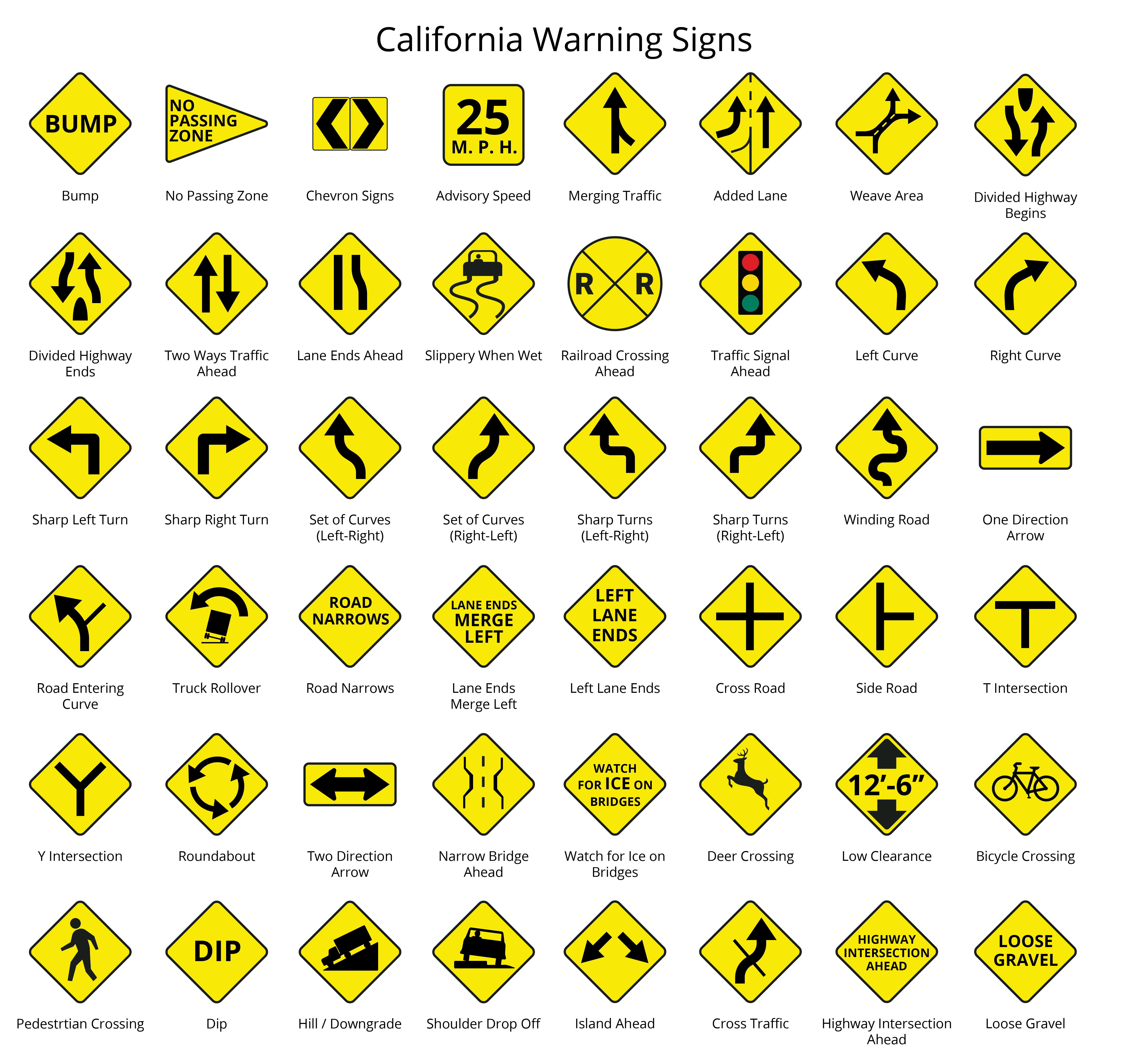
Below are some common warning signs and their meanings:
- Chevron Signs: When you see these signs, it means there’s a sharp curve or turn ahead.
- Advisory Speed: The maximum safe speed is lower than the standard speed limit in that area because of a curb, ramp, or potential hazard.
- Added Lane: This sign is posted close to the point where two roads meet, indicating that you don’t need to merge.
- Weave Area: The road you’re on will merge with another roadway, so you should pay close attention to the traffic around you.
- Road Entering Curve: Approach the intersection with caution because the main road curves one way and a side road joins on the other.
- Two-Direction Arrow: This road sign is posted at intersections, telling drivers that they can only go left or right (not straight ahead).
- Island Ahead: You can drive on either side of the traffic island where the sign is posted. It also means you need to watch out for the island itself as a potential obstruction.
- Cross Traffic: Slow down and drive cautiously because one or more side roads cross the main road.
Guide Signs in California
Guide signs provide directions or information on distances, route designations, tourist attractions, airports, highways, and more. As the name suggests, their role is to guide road users. These traffic signs usually have a green, or blue background and text or symbols.
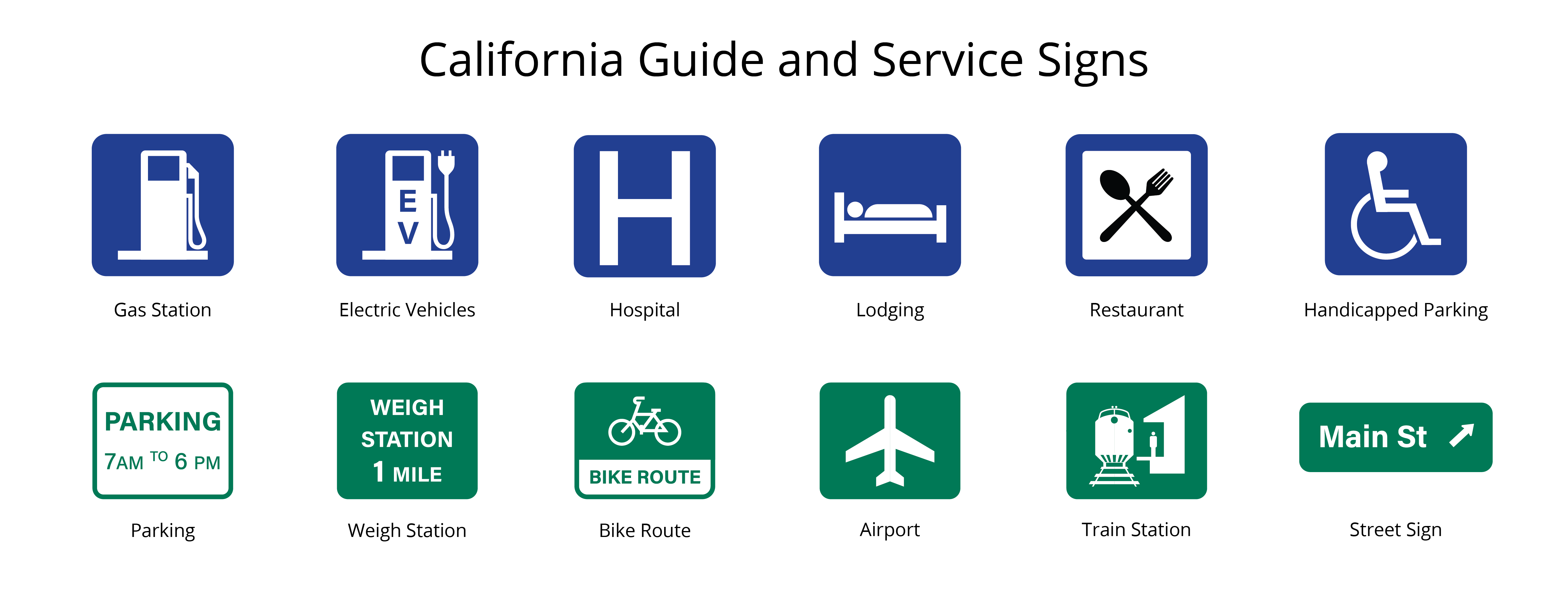
For example, HOV lane entrances are marked by a green rectangular sign, while hospital signs feature the letter H in white on a blue background.
Work Zone Signs in California
Work zone signs are temporary road signs that are placed in construction or work zones. You’ll recognize them by their square or diamond shape and orange background.
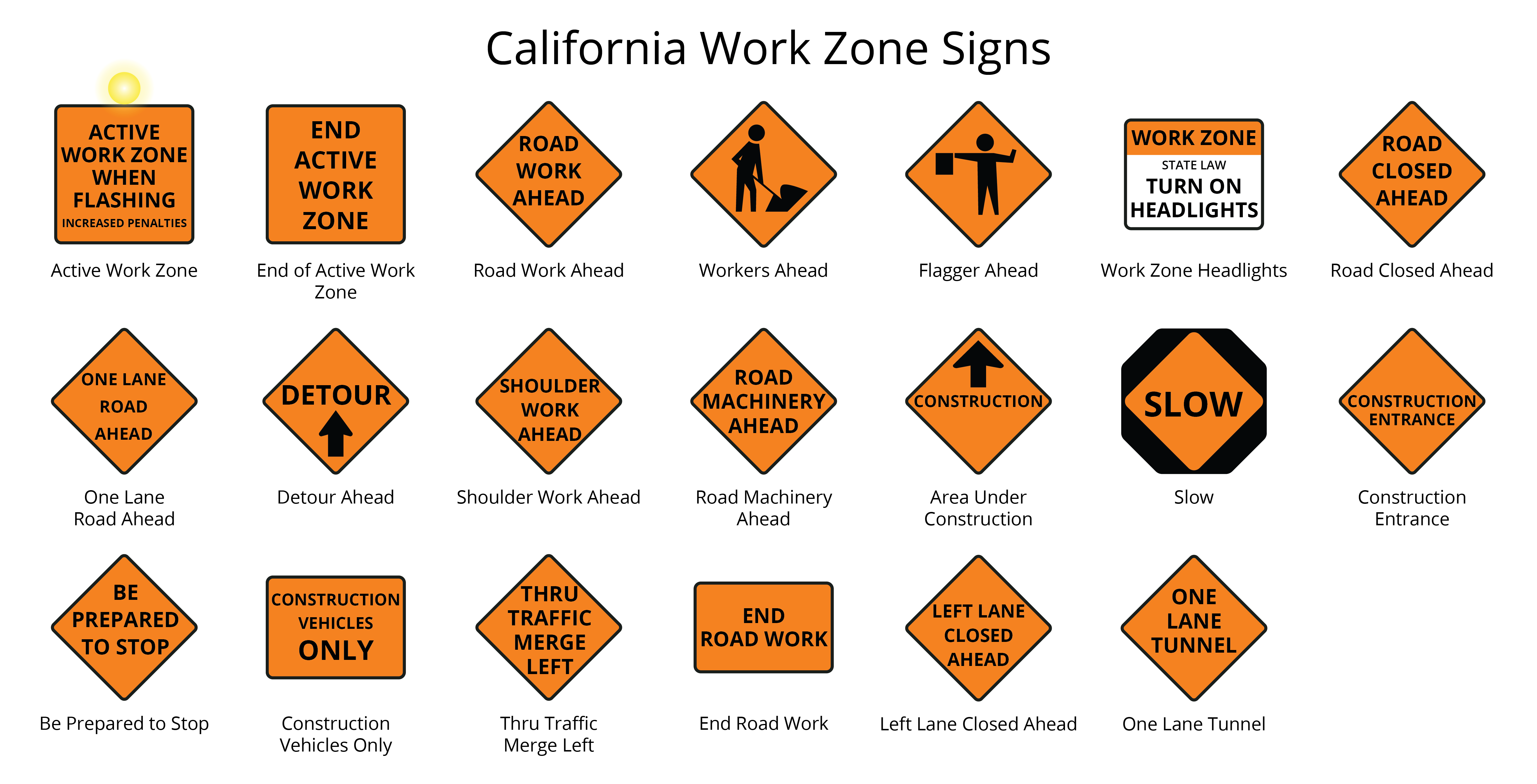
Note that work zones may represent a temporary change to regular speed limits and other rules, so it’s important to follow them carefully.
School Signs
As the name suggests, these road signs reinforce safe driving practices around schools. You should pay extra attention to your surroundings and be prepared to slow down or stop the car if necessary.
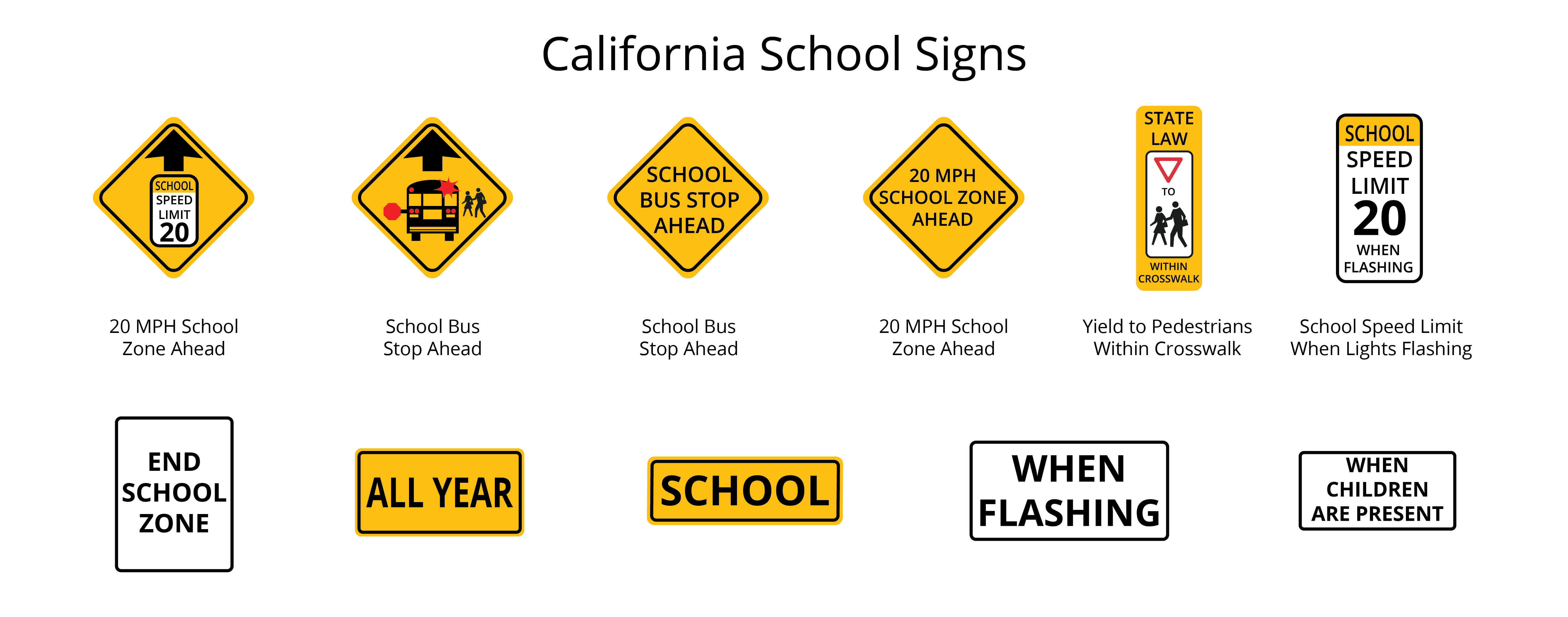
Generally, school signs are accompanied by regulatory traffic signs indicating the speed limit.
If you exceed this limit, you’ll get a speeding ticket and points on your driving record. There’s also a risk of being charged with a misdemeanor or felony. Also note that California speeding tickets are more expensive in school zones.
Some school zone signs have lights that flash when the speed limit applies. These usually display a message like, “School speed limit 20 when flashing.”
Others specify the circumstances or time of the day when drivers must follow the school zone speed limit. The speed limit may apply all year round or only when young children are present.
Service and Recreation Signs
Expect to see these road signs near tourist attractions, gas stations, hotels, and areas with specific facilities or activities. You’ll recognize them by their white, blue, or brown background and suggestive images.
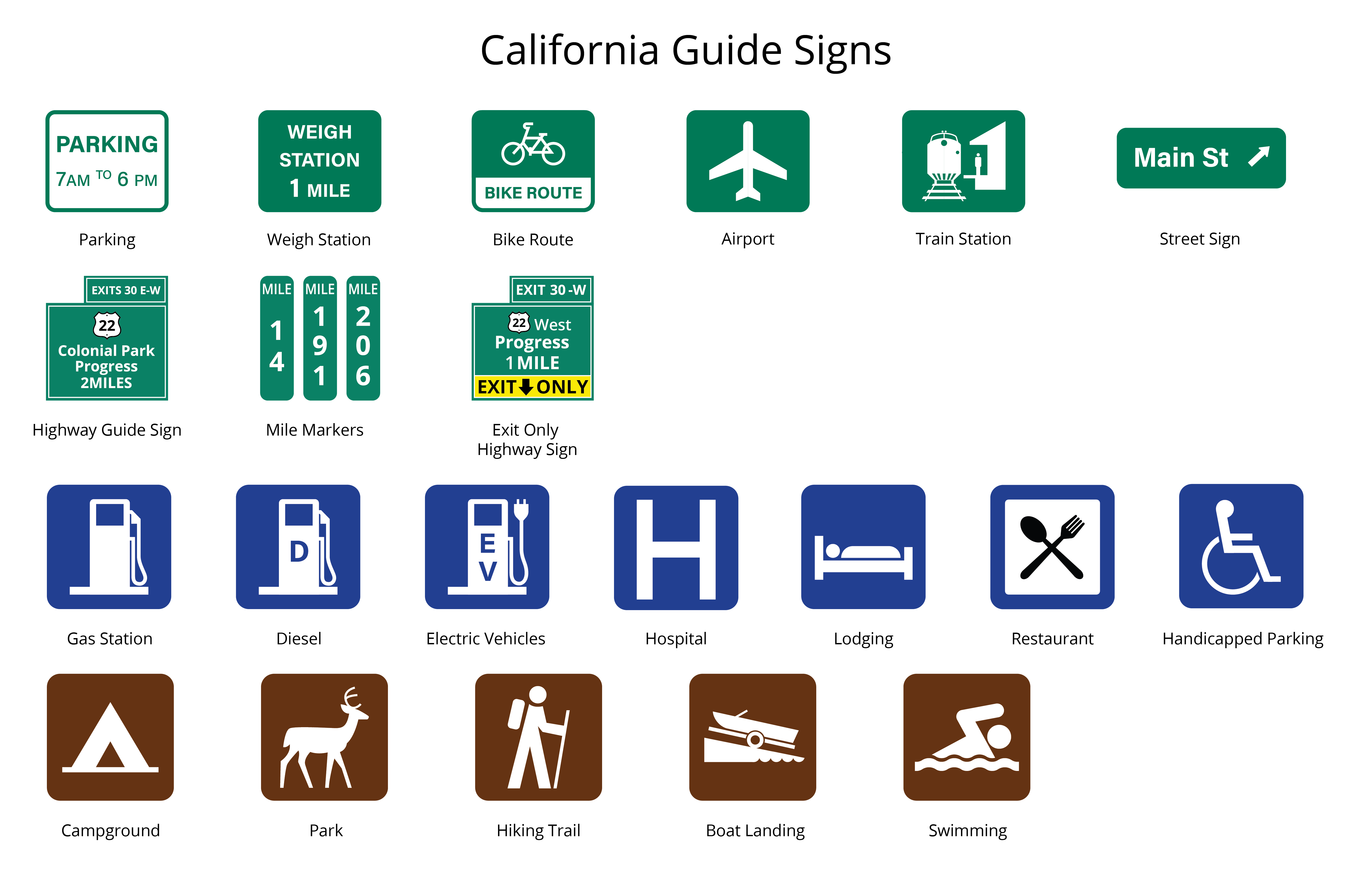
For instance, picnic areas are marked by a square sign featuring a white picnic table on a brown background. If you’re approaching a hotel, motel, or B&B, you’ll see a blue square sign illustrating a person in a bed.
Specialized California Highway Signs
California has more than 2,466 miles of interstate highway, plus mountain areas, deserts, beaches, and other natural settings. These areas are often marked with specialized highway signs to warn, inform, or guide drivers. Let’s see a few examples:
- Adopt-a-Highway signs
- Historical landmark road signs
- Mile marker signs (e.g., the Sonora Pass sign)
- Spade-shaped state route signs
- Wildlife crossing signs
- Coastal access signs
- Scenic route signs

Understanding Road Signs and Colors
Most road signs have specific colors and shapes based on their meaning. For instance, red is always used for regulatory signs, such as “STOP” and “NO U TURN,” while yellow serves as a warning.
Let’s see what each color means to road users.
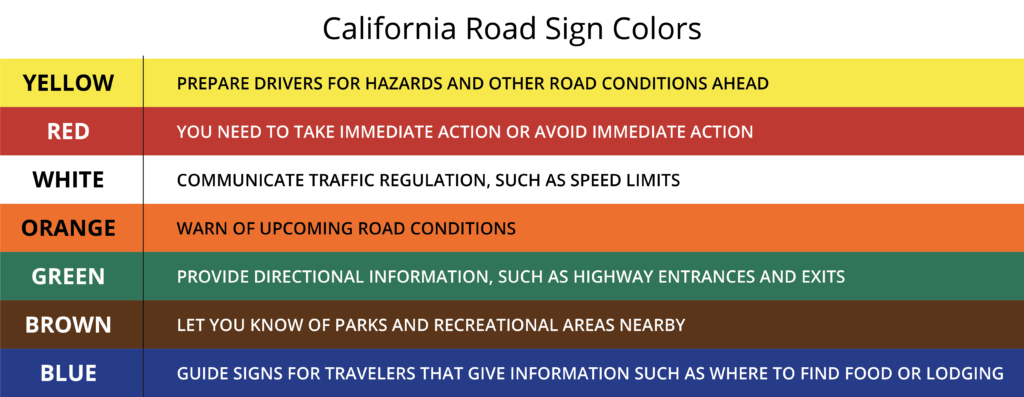
Understanding Road Sign Shapes
Traffic signs come in different shapes, from squares to circles, pentagons, and octagons. Each shape carries a different meaning, whether it’s a warning, a restriction, or driving directions.
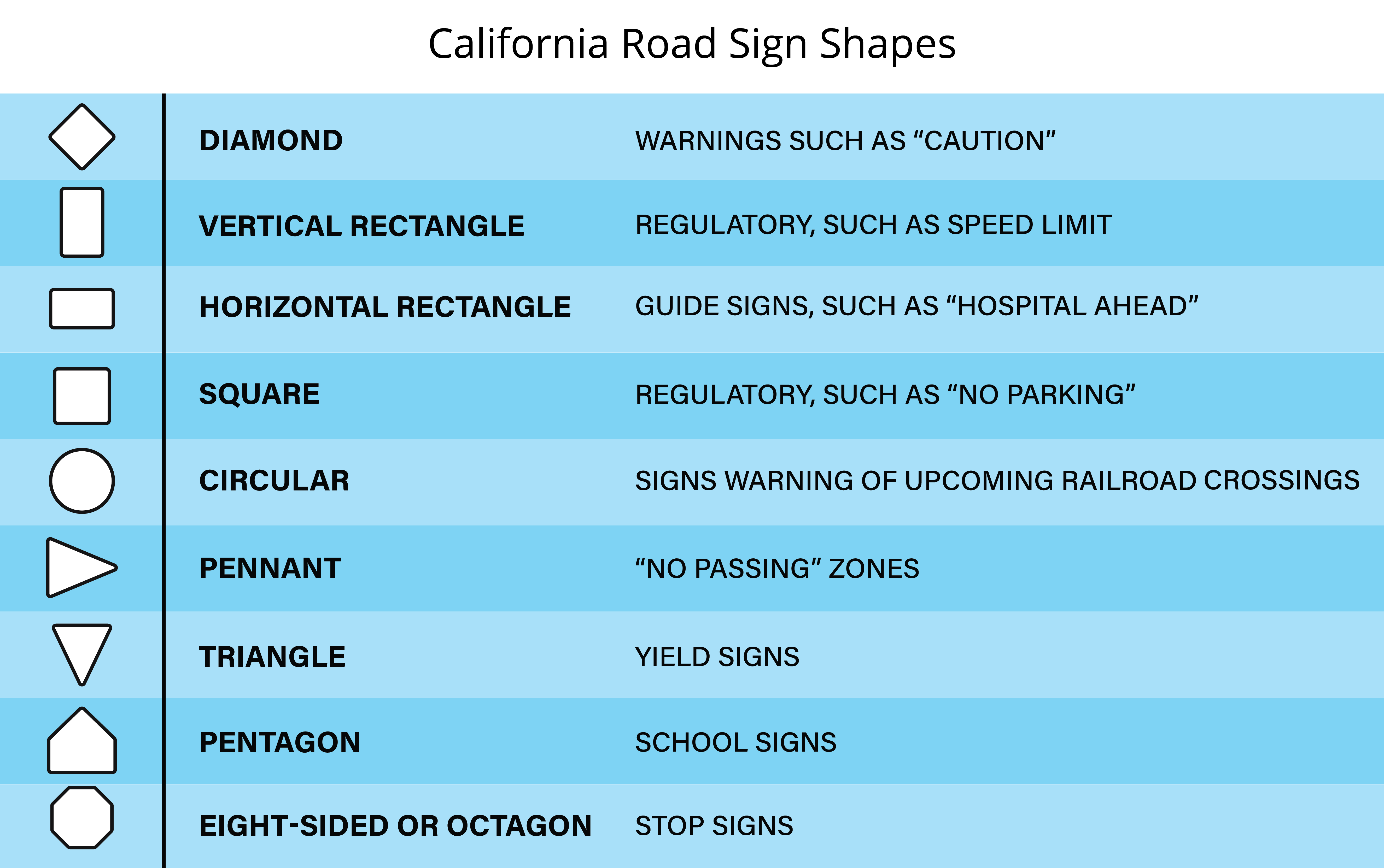
When you’re on the road, check the shape and dominant color of the traffic signs you encounter.
California Road Signs Test
Understanding California road, traffic, and highway signs and their meanings is a requirement for obtaining (and sometimes renewing!) your driver’s license. Prospective drivers must take a written knowledge test to get an instruction permit, or learner’s permit.
The test is available in 35 languages and can be completed online or in person. It consists of 46 multiple-choice questions and requires a passing score of at least 80%. The questions cover topics from the California Driver Handbook, such as:
- Road signs and their meanings
- Traffic signals and pavement markings
- Speed regulations
- Safe driving practices
- California bicycle laws
- Distracted driving laws
- Right-of-way rules
- Driver responsibilities, including vehicle registration
- Parking maneuvers
Our advice is to start by reading the California Driver Handbook. Then take the practice tests offered by the California DMV.
To increase your chances of success, study the 2024 California DMV Permit Practice Guide. It contains 200+ multiple-choice questions just like those you will find on the exam. You’ll also get:
- A FREE road signs cheat sheet
- Step-by-step instructions for obtaining your learner’s permit
Our guide is available in both digital and physical formats, and the digital version has a 30-day money back guarantee.
The Importance of California Traffic and Road Signs
Traffic signs are meant to keep drivers, pedestrians, and cyclists safe on the road. They promote responsible driving and show us how and where to find nearby schools, hospitals, parking areas, and other facilities.
Their role is to:
- Promote Safety: Traffic signs warn drivers about potential hazards, such as slippery roads or sharp turns, which may help prevent accidents.
- Guide and Inform: Some road or highway signs provide directions or information about service points, landmarks, or campgrounds.
- Control Traffic Flow: Stop, Yield, No Left Turn, and other road signs regulate traffic movement to reduce congestion and collisions.
- Help Drivers Make Decisions: Drivers can adjust their routes as needed by paying attention to traffic signs, such as those placed in construction zones or on highways.
- Protect Vulnerable Road Users: The traffic signs posted in school zones or other designated areas protect children, pedestrians, cyclists, or other vulnerable road users.
- Support Law Enforcement: Traffic signs define the rules of the road, assisting police officers with their efforts to ensure compliance.
What Happens If You Ignore or Miss Traffic Signs?
Failure to obey traffic signs and signals is punishable by a base fine of $238 plus court and administrative fees. It will add one point to your license and raise your auto insurance premiums. There’s also a risk of getting in a collision, endangering other road users, or impeding the flow of traffic.
The easiest way to mask that point is to plead guilty and go to traffic school. Not only will this help you maintain a good driving record, but it can also prevent your insurance rates from increasing. Plus, it’s an opportunity to refresh your knowledge of California road signs and traffic laws. (Learn more in Is Traffic School Worth It?)
If you’re eligible for traffic school, choose a DMV-approved course like the one we offer. Our course is available on any device and includes interactive materials for a streamlined learning experience. You can take the course in English, Chinese, or Spanish and contact us 24/7 with any questions you may have.
At Best Online Traffic School, you can complete the course in just two or three hours. If, for some reason, you don’t pass the final exam on the first try, you can retake it as many times as you need without paying extra. See how traffic school works to find out more!
Start traffic school for FREE today.
FAQs about California Road and Highway Signs
Many road signs have similar shapes, colors, and symbols, which can be confusing for novice drivers. That’s why we have compiled a list of answers to some frequently asked questions.
What does an “activated blank-out” road sign mean in California?
Activated blank-out is an electronic traffic sign that only displays a message when it’s relevant or necessary. When inactive, the sign appears as blank or black. When activated, it illuminates or displays a message. These are typically used to convey time-sensitive information, such as lane restrictions, variable speed limits, and dynamic warnings about things like weather or road work.
Is there a separate road sign test in California?
No, there isn’t. Any questions about California road signs are found in the knowledge test you must take when applying for a learner’s permit.
Is there a separate road sign test in California?
No, there isn’t. Any questions about California road signs are found in the knowledge test you must take when applying for a learner’s permit.
Is there a bear in the California road sign?
In the early 20th century, the Automobile Club of Southern California (ACSC) and the California State Automobile Association (CSAA) erected state highway signs that included a bear symbol, reflecting the bear from the state flag.
Currently, the standard state route signs feature a spade-shaped design with a green background and white numerals, without any bear imagery.
California also uses bear warning signs in areas where bear crossings are common. These signs typically feature a silhouette of a bear to alert drivers to the potential presence of bears on the roadway.
Why are some road signs black and white?
The black-and-white color scheme is used for regulatory signs. These include “One Way,” “Bus Lane, “No Turns,” “Do Not Pass,” “No Motor Vehicles,” and others.
What color are California street signs?
Most streets in California are marked by green or blue signs with white lettering.
